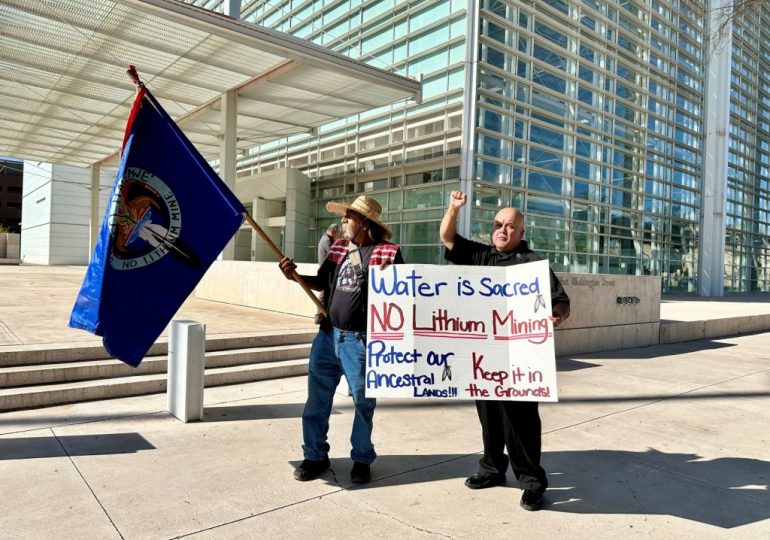This story was originally published by the Arizona Mirror
When Hualapai Spiritual Leader Frank Mapatis visits Ha’Kamwe’, the tribe’s sacred spring, to conduct any type of ceremony, the area must be completely quiet so that he can hear the water and connect with the land.
Mapatis said that as part of his traditional ways of life, when he is in prayer at Ha’Kamwe’, he hears the water sing, and when it sings, he connects with the creator to conduct ceremonies.
He has provided purification, healing and coming-of-age ceremonies at Ha’Kamwe’ for decades and visits the spring at least twice a month. The spring is also utilized for tribal members’ funeral ceremonies.
Not being able to hear the water, conduct ceremonies or provide traditional teachings to the Hualapai youth who join him during his visits to the spring are among Mapatis’ top concerns for the proposed exploratory drilling lithium project in the Big Sandy River watershed near the tribe’s sacred spring.
“It would stop me from doing ceremony,” he said about the drilling project as he testified in federal court on Sept. 17. He believes drilling in that area will traumatize the earth and water, and he would not want to use that area for ceremonial purposes due to that trauma.
Mapatis said he could continue his ceremonial practices in other places, but they would not have the same impact as doing them at Ha’Kamwe’ because of the water’s healing properties.
“It wouldn’t be as effective in other areas,” he added.
Ha’Kamwe’ is featured in tribal songs and stories about the history of the Hualapai people and their connection to the land. According to the tribe, the historic flow and spring temperature are essential for its traditional uses.
Mapatis was one of several Haluapai tribal members who testified during the Sept. 17 preliminary injunction hearing at the U.S. Federal District Court in Phoenix, where the tribe is fighting to extend the pause on drilling for the Big Sandy Valley Lithium Exploration Project for the duration of the tribe’s lawsuit seeking to block the project entirely.
The project allows a mining company to drill and test more than 100 sites across BLM land surrounding one of the Hualapai Tribe’s cultural properties, among them Ha’Kamwe’, a medicinal spring sacred to the tribe.
Tuesday’s hearing came after a federal judge granted the Hualapai Tribe’s request for a temporary restraining order against the U.S. Bureau of Land Management, temporarily freezing the exploratory drilling project.
The restraining order was granted weeks after the Hualapai Tribe filed a lawsuit against BLM, following years of the tribe actively voicing its concerns about the mining effort.
Ha’Kamwe’ is located within the Hualapai Tribe’s property known as Cholla Canyon Ranch, and the boundaries of the Big Sandy Valley project nearly surround the entire property. Only one portion of the tribe’s land does not border the drilling project.
The spring is recognized as a traditional cultural property and is eligible to be listed on the National Register of Historic Places, and the tribe’s lawsuit claims that the project’s approval violates the National Environmental Protection Act and the National Historic Preservation Act.
The lawsuit asks for full compliance with the National Historic Preservation Act (NHPA) and the National Environmental Policy Act (NEPA), which includes having the BLM take a “hard look” at the exploration activity’s environmental impacts and consider the implications of its actions on historic properties.
The lawsuit claims that BLM approved the mining project without appropriately considering a reasonable range of alternatives or taking a hard look at water resources under the NEPA and moved forward with the project without providing mitigation measures under the NHPA for Ha’Kamwe’ and other resources essential to the tribe, thus violating both acts.
Out of concern for Ha’Kamwe’, the tribe submitted multiple public comments, sent several letters of concern, and participated in tribal consultations with BLM throughout the Big Sandy Valley Lithium Exploration Project planning phase.
Big Sandy, Inc., a subsidiary of Australian mining company Arizona Lithium, leads the project and has sought approval since 2019. Arizona Lithium is not a direct party in the Hualapai Tribe’s lawsuit, but it filed a motion to intervene in the case. Humetewa granted the request in August, allowing the company to defend against the tribe’s efforts to stop the project.
BLM’s approval of the Big Sandy Valley Project allows the mining company to drill and test up to 131 exploration holes across 21 acres of BLM-managed public land to determine whether a full-scale lithium mining operation could be viable.
‘How we connect to our ancestors’
Throughout the hearing, several Hualapai tribal members and supporters sat in the courtroom listening to the hearing while others sat outside the Sandra Day O’Connor courthouse holding signs backing the tribe.
Hualapai tribal member Ivan Bender, 60, from Peach Springs, showed up to the courthouse in support of his community, carrying a flag that said, “Protect Ka’kamwe’. No lithium mining.”
“That spring has a life of its own,” Bender said. “The water source we’re trying to protect is part of our sacred waters.”
The preliminary injunction hearing lasted more than six hours, during which Judge Diane Humetewa heard witness testimony from all parties involved in the case as she weighed the tribe’s request to keep the drilling on hold.
Testimony surrounded the way the project would directly or indirectly impact the Hualapai Tribe’s ability to carry out their cultural and traditional ways of life at Ha’Kamwe’, and whether the drilling that will take place as part of the project will harm the water that feeds into the hot spring.
Ka-voka Jackson, the director of the Hualapai Department of Cultural Resources, was the first witness, and part of her testimony focused on how the Hualapai Tribe utilizes the area for cultural and traditional purposes — and how drilling can directly affect those practices.
Jackson told the court that tribal members often visit Ha’Kamwe for traditional practices or to gather and harvest culturally significant plants from surrounding public lands.
“That is how we connect to our ancestors,” Jackson said.
The tribe’s lawsuit states that the lithium project will create noise, light, vibrations, and other disturbances that will degrade Ha’Kamwe’s character and harm tribal members’ use of the spring for religious and cultural ceremonies.
Jackson said the project’s impacts could cause irreversible damage, affecting the water supply to the sacred springs and destroying the land.
“(It can) create a lot of negative energy and create a hostile environment,” she said.
As part of its environmental assessment, BLM listed several short- and long-term effects, including the temporary disruption to cultural practices at or near Ha’Kamwe’ and an impact on native wildlife and vegetation of up to 21 acres.
But even with these effects included in the assessment, BLM concluded that Phase 3 of the Big Sandy Valley Lithium Exploration Project would not significantly negatively impact the quality of the area, so an environmental impact statement was not needed.
“Visual, noise, and vibration effects from drilling activities would be temporary,” BLM wrote in its final report. “Coordination with and providing notice to the Hualapai Tribe of drilling activities in the vicinity of the Ha’Kamwe’ may reduce impacts to cultural practices at or near the hot spring.”
To provide the court with perspective on the distance of the drilling locations near Ha’Kamwe’, Ivan Martirosov from Navajo Transitional Energy Company testified on behalf of the defendants.
Martirosov is the project manager for the Big Sandy Valley Lithium Exploration Project with Navajo Transitional Energy Company (NTEC), a mining and energy company owned by the Navajo Nation.
NTEC entered into a mining agreement with Arizona Lithium in March. Under this agreement, the Navajo-owned company is responsible for permitting, exploration drilling, mine design, environmental assessments and development for the Big Sandy Lithium Project. NTEC has worked with Arizona Lithium since December 2022.
Martirosov is in charge of overseeing and executing the Big Sandy Lithium Project. He told the court that he walked all approved drilling sites on foot and described the site’s proximity to the Hualapai’s cultural property.
Of the 131 drill sites approved for the project, Martirosov identified 22 with a line of sight to Ha’Kamwe’, a majority located on the north side.
Martirosov said that he was restricted from accessing Ha’Kamwe, noting that the drill sites that do not have a line of sight of the cultural property were due to distance and terrain.
BLM: Concerns are ‘overblown’
At the end of the day-long hearing, Humetewa ordered all parties to file briefs outlining their arguments for why the injunction should or shouldn’t be granted. She said she would issue a ruling in the near future.
During the hearing, Humetewa said that she was tasked with determining what process BLM took in connection to NEPA and their Section 106 process.
The Section 106 process seeks to accommodate historic preservation concerns through consultation among an agency official and other parties interested in the undertaking’s effects on historic properties. The consultation aims to identify historic properties potentially affected by projects and seek ways to avoid, minimize, or mitigate any adverse effects.
The process is usually conducted in four steps: initiating it, identifying historical properties within potentially affected areas, assessing any potential adverse effects on any eligible historic property, and seeking to resolve any adverse effects.
Humetewa said in court that she wants to know where in the records she can find BLM’s engagement in those processes so she can fully understand the discussion about either approving or denying the project. That way, she said, she can understand what considerations went into the final environmental assessment and the NEPA assessment.
Earthjustice Senior Attorney Laura Berglan, who is part of the team representing the Hualapai Tribe, said she feels positive because their team presented all the points they wanted.
“I think it went well and we’ll see how it turns out,” she added.
BLM’s attorneys told Humetewa that the impacts this project will have on Ha’Kamwe have been “vastly overblown,” noting how their expert clearly testified that the water and temperature will not change due to the drilling in the project.
The tribe had its own expert testify. Winfield G. Wright, a certified hydrologist and president of Southwest Hydro-Logic, said he produced a report for the tribe about the water sources that feed into Ha’Kamwe’. Wright said his analysis found that the groundwater system that flows into the hot spring is very fragile, and any disturbances around the area can disrupt the water, the chemistry and the temperature.
Wright said a mixture of shallow and deep waterways feed into Ha’Kamwe’, and the BLM’s environmental assessment simplified identifying where the water comes from by saying a confined lower aquifer feeds it.
“It’s not a confined aquifer,” he said, noting that the lower aquifer in the Big Sandy Valley is not the only source of water for the spring. “The whole valley is connected because of the fractures.”
But Peter Burck, a hydrologist with the BLM, testified that the lower fractures of the lower aquifer are a more likely source of water for Ha’Kamwe’.
Burck said that Wright’s claim the water comes from multiple sources is not conclusive. He said he did not see anything in Wright’s report that would lead him to conclude that the spring water source is a mixture of multiple flows.
He said that the likelihood of the drilling from Phase 3 of the Big Sandy Lithium Project encountering water or affecting the temperature of Ha’Kamwe’ is low.
BLM also told the court that any visual and noise disturbances from the drilling does not qualify as irreparable injury and is instead temporary.
But Jackson said her tribe made a good case that the project would cause irreparable harm because they had people testify who had already experienced it.
“This is irreparable; you can’t go back and redo ceremonies,” she said. “There’s no such thing.”
Jackson said she understands that the court wants more clarification on whether or not the BLM took the appropriate steps under the NEPA and NHPA policies before making a final decision.
“We believe that they didn’t take into consideration the effects on Ha’Kamwe’,” Jackson said, adding that it is eligible for registration on the National Historic Register and a traditional cultural property.
Jackson said it deserves a thorough process included in the NHPA and NEPA.
“I am proud of our people for sticking up for what we believe in and asserting our arguments,” she said. “Now, we just wait.”
Hualapai Chairman Duane Clarke echoed Jackson’s sentiments about how their team and tribal members presented a good case in court, and said he prays that the court’s decision goes with the Hualapai people.
Arizona Attorney General Kris Mayes filed an amicus brief before the hearing supporting the Hualapai Tribe’s request for the preliminary injunction.
“The sacred Ha’Kamwe’ spring has sustained the Hualapai people for generations, and its protection is critical for the Tribe,” Mayes said in a written statement. “The failure to properly evaluate the impact of this project on such an important water source is unacceptable.”
The amicus brief urges the court to take action to protect Arizona’s water resources from potentially irreversible damage posed by exploratory drilling near the Hualapai Tribe’s sacred spring.
“The BLM must fulfill its obligations under NEPA and fully evaluate this project’s impact on local water resources,” Mayes said. “I am proud to support the Hualapai Tribe’s efforts to protect their precious cultural and water resources.”
The amicus brief highlights the risk of irreparable harm to Arizona’s water resources if exploratory drilling is allowed to proceed without a comprehensive review. It also requests that the court grant a preliminary injunction to stop drilling activities while the case is being heard to protect Arizona’s water sources from potential compromise.
Hualapai Tribe fights to extend ban on lithium drilling it says jeopardizes a sacred site is an article from Energy News Network, a nonprofit news service covering the clean energy transition. If you would like to support us please make a donation.
Leave a comment





